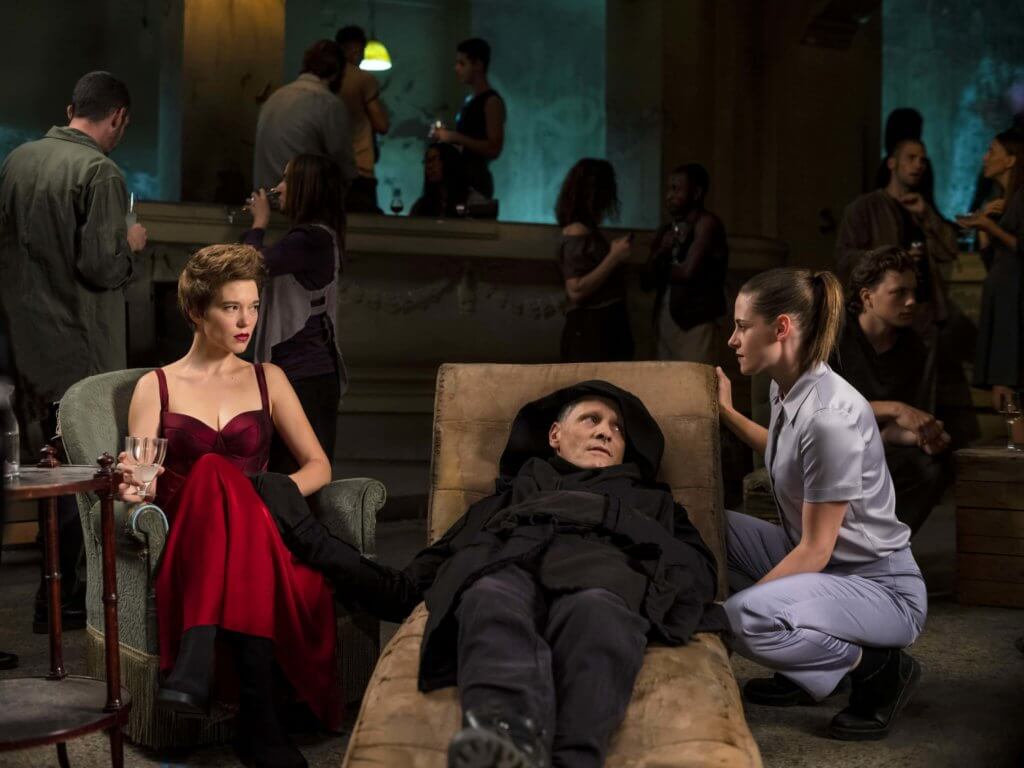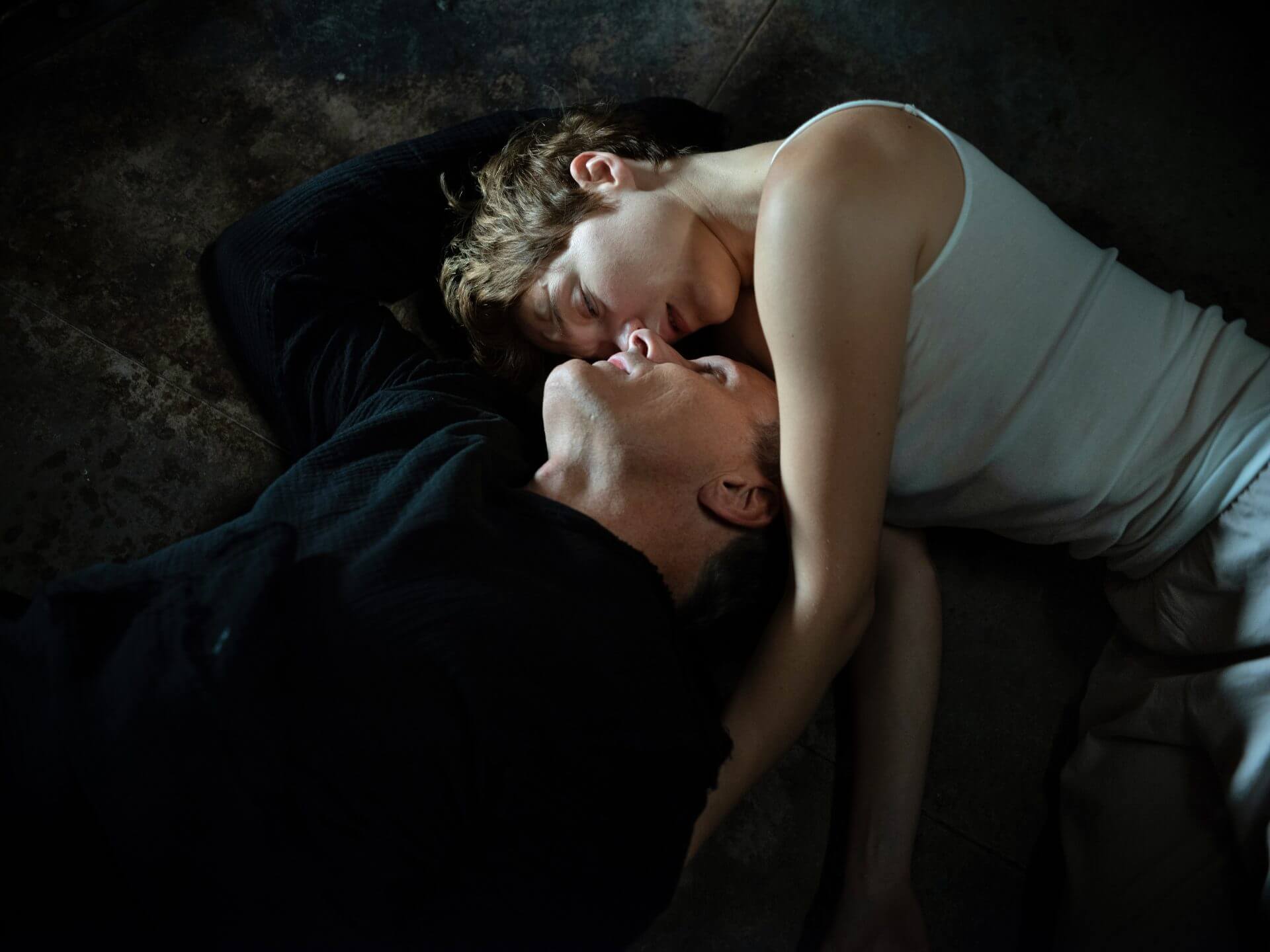David Cronenberg is having a moment. Internet-savvy distributor Neon released the provocative teaser of Cronenberg’s Crimes of the Future seconds within the announcement of the film’s inclusion in the main Competition, and it set the internet aflame with its flashes of body horror, heralding the return of the 79-year-old director like he never left.
David Cronenberg has always been ahead of his time. His 1996 movie Crash repulsed then-jury president Francis Ford Coppola so much that Coppola refused to give it an award against his fellow jurors’ wishes, settling for a “Special Jury Prize for courage, daring, and originality.” Its spiritual daughter Titane finally took home the Palme d’Or 25 years later. Earlier this year, hyperpop star Charli XCX released an album aptly titled CRASH, repurposing the movie’s aesthetics of metallic erotica to a #1 position on the UK sales charts.
And now David Cronenberg has returned to show these younglings how it’s done. Crimes of the Future is wicked, weird, prestige, lo-fi, erotic, earthly, queer – all things clashing together to create a half-synthetic, half-authentic beastly creature. It never does things predictably, only excitingly; it is deeply steeped in movie-making traditions, while raising questions of the future and now.
The year and city are unknown. Saul Tenser (Viggo Mortensen) keeps growing new organs in his body. To regulate this, he and his partner Caprice (Léa Seydoux) stage theatrical “performance art” in which she surgically excises these organs from his body. This attracts the attention of organs cop Timlin (Kristen Stewart) and others in the community of evolving humans. Saul and Caprice go around asking for opinions as they decide whether or not to perform a public autopsy on what might be the first naturally synthetic human in existence.
As many critics have expressed, some disappointingly, reports of gore have been greatly exaggerated. Or there should never have been these reports at all, as Cronenberg is not at all interested in shocking the audience with yucky organs or violence (for that, see the Competition’s comparatively amateurish Holy Spider). He is interested in the slow process, not the extreme product, because he knows it is the former in which emotion gradually, maximally unfolds.
As in Crash, this process is eroticized. As Stewart literally says, “surgery is the new sex.” Perhaps this is why Cronenberg speaks to queer and women artists like Julia Ducournau and Charli XCX, because Cronenberg’s body fetish is queerly rebellious. He films his characters’ perversions like a precious child, never judging but always protecting and preserving them. His cinema, like queer cinema, is that of sensuality and pleasure, even if it’s of exploding heads and torsos. The explicit eroticism (but not sexuality) of Crimes of the Future (the characters literally climax as scalpels slice through their skin) speaks directly to the desire of queer audiences, but Cronenberg’s reach is more global. With his movies, Cronenberg makes a very convincing argument that everyone should want to have their body sliced open.
For such an outré story, the aesthetics are surprisingly held back. Like the best sci-fi movies, Crimes of the Future is retro-futuristic. It’s no surprise that this movie was shot in Athens, one of the oldest cities in civilization; all of the sets have an earthly aesthetic, like half the movie was shot in caves. Currently impossible technology manifests itself in black-and-white, CRT televisions; posters are written in mid-century, modernist typography. This connects the movie to an authentic, almost primitive desire. Clashing is the film’s modus operandi; the blocking and framing are both classical in theater traditions and just off-kilter enough to keep us on edge. The same goes for Howard Shore’s score of classically rigid and predictable chord progressions played through shimmery synths. The special effects of the film are likely a combination of practical and digital, but their Giger-esque visual weight is unmissable. In Crimes of the Future, as the machines twitch and turn, you feel it in your bones.

Like archaism and dystopia, prestige and B-movie–ness also clash. Since the mid-1990s, Cronenberg has migrated from low-budget, grainy indie films to slick, shiny Palme d’Or–competing prestige. The cast is so starry that the lead actress is one of the two actors on the planet to actually have her own Palme d’Or. Yet Cronenberg has not forgotten his makeshift roots. Many lines are hollow slogans that only consist of big, buzzy, meaningless words. The supporting actors turn in intentionally bad, wooden performances, especially Kristen Stewart, who delivers a masterclass in camp as a woman singularly devoted to being horny. She basically does an impression of the public’s imagination of a Kristen Stewart performance, continuing her work that interrogates her celebrity persona. She has never been this odd and funny.
People who understand that Phantom Thread is the funniest movie of the last decade will understand Crimes of the Future as a great comedy. As in that costume drama, the dead seriousness of Crimes of the Future empowers the movie’s fertile humor. The best example is the scene in which Léa Seydoux, dressed in an haute couture gown, watches a performance artist scar her face in an 18th-century-looking European mansion. Never has someone looked so glamorous and serious while watching someone do something so cleverly stupid. Camp and performance and prestige and grotesqueness and trashiness coalesce to create something constantly strange, exciting, and new. The best cinema is when there are multiple things going on, when you don’t know what you’re supposed to feel.
Yet don’t let the irreverence of Crimes of the Future distract you from its emotional potence. The film has what is already a sparse script with mostly gibberish dialogue, yet with just a line or two, Cronenberg sneaks in highly relevant questions of humanity. A brief allusion to plastic waste contextualizes the entire movie within climate change, firmly placing the film’s sci-fi and horror in the now. Its even bigger thematic point is raised by the same character, who is supposedly the “bad guy” of the film. He questions Saul’s hacking of the body and proposes an alternative worldview. Not only does Cronenberg flip the movie on our heads, he also transforms the film into trans narrative, making a plea against the policing of bodies and for bodily fluidity. As in the best scripts, both heroic and villainous sides make compelling arguments.
For a movie so concerned with bodies, it is perfectly cast. I have already lauded Stewart’s textbook lesson in camp. Poor Frenchwoman Léa Seydoux struggles with locating the emotion behind words like “beatific,” yet she is nonetheless the epitome of femme fatale. It is Viggo Mortensen’s lead performance that quietly anchors the film. In a film like this, in which spectacle and flashy women occupy the spotlight, the performance of a passive and sturdy protagonist like Mortensen’s is often taken for granted. But as Mortensen quietly retreats into the shadows, he is building the argument for his character’s transformation scene by scene, until that last close-up reaches an emotional crescendo that crystallizes everything with pain, relief, and epiphany. It is impossible to imagine other actors playing any of these roles, and Mortensen literally takes breaths away.
If there are two problems with Crimes of the Future, the first isn’t even Cronenberg’s fault. Because of what appears to be a lack of budget, the movie doesn’t construct enough scale. The action mostly takes place in the same few rooms, and there is never a sense of the larger city, country, or planet. As such, some of the story’s scale is literally stated not shown. But I suspect that is not Cronenberg’s concern anyway; why explore other locations when you have the infinite maze of our bodily systems? The other problem is that the plot seems quite slow and directionless at first, with Saul and Caprice just going to different people with no apparent reason. There doesn’t seem to be an event it’s building up to. But as the film reaches its conclusion, its thematic concerns become clear, and the entire development of the film makes sudden sense. Like the best films, it requires patience, but Crimes of the Future cuts to black once it answers its questions. Cronenberg does not waste a single minute of the audience’s time.
Some great films are instant classics that win over everyone and steamroll the entire year. Some other great films instantly divide and polarize the room. Crimes of the Future is already the latter, with the USC @ Cannes Classics apartment’s opinions ranging from heavy disappointment and tepid indifference to effusive adoration. But like Saul and Caprice’s performances, as public opinion swirls and evolves around the film, it will stand tall as art. The brouhaha will die down and one day humans will evolve, yet Crimes of the Future will always live.
